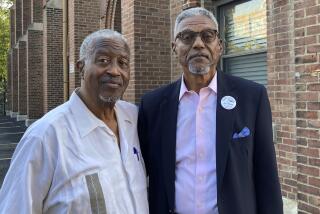The Long Road to Truth About Iraq’s Weapons
WASHINGTON — For Cees Wolterbeek, a handsome Dutch colonel with a PhD in chemistry, the first tip-off was the knitting.
The colorful skeins of wool and long needles resting on a desk struck the U.N. weapons inspector as a curious discovery in the bombed-out ruins of Iraq’s massive Muthanna plant that Iraqis claimed had manufactured pesticides. He decided to keep poking around.
Hours later, in a desk buried deep under debris wrought by U.S. warplanes during Operation Desert Storm about six years earlier, Wolterbeek found a stack of medical records. Each neatly recorded the illnesses that struck Muthanna workers--clues that would mark a turning point for the U.N. weapons inspectors.
As Wolterbeek read the records, he realized that his team had uncovered the infirmary in what turned out to be Iraq’s most notorious chemical weapons plant.
More important, the find last year eventually yielded long-elusive information about the structure of Iraq’s weapons programs. Arms experts finally were able to identify the three elite organizations hiding the deadliest arms and the handful of officials responsible for their production.
The information meant that the U.N. disarmament effort--long, tense and fraught with problems though it may have been--had achieved a major breakthrough. But at the same time, it made the U.N. commission investigating Iraq’s weapons programs more of a target. Indeed, inspectors say the Muthanna revelations helped trigger Iraqi President Saddam Hussein’s current confrontation with the U.N.
“A lot of the reason the Iraqis are behaving this way is because we have been pursuing with enormous vigor our conviction that these organizations and people are the ones responsible for lying to the commission and retaining weaponry,” said Charles Duelfer, vice chairman of the U.N. commission and its highest-ranking American.
“As we get closer to the truth, the Iraqis are trying to hold us at an ever greater distance,” Duelfer said.
The United Nations Special Commission on Iraq--or UNSCOM, as it is known at the U.N.--is now widely viewed by experts as one of the most successful disarmament programs in history. President Clinton pointed out this week that UNSCOM has destroyed more Iraqi weapons, piece by piece, than did the punishing allied air and ground assaults by 32 nations during Operation Desert Storm.
*
But closing in on the truth has been a long haul. The U.S.-led coalition originally calculated--erroneously--that Iraq would be so eager to get U.N.-imposed economic sanctions lifted and resume oil sales that Hussein would quickly surrender his chemical, biological and nuclear weapons and his long-range missiles.
Instead, the regime engaged in an extensive effort to hide at least half of its stockpile, according to Rolf Ekeus, former head of UNSCOM and now Swedish ambassador to the United States.
Iraq’s declared postwar inventory seriously underreported its nuclear efforts, acknowledged only 50% of its capability to produce chemical weapons, denied it had an offensive biological program and listed only a portion of its missiles. “And that’s based on what we know now. It’s quite likely there is even more we don’t know about, especially the chemical and biological weapons,” Ekeus said.
The U.N. program in Iraq has ranked as among the world’s most unusual disarmament efforts. U.N. inspectors are looking for research papers as much as for weapons. And they spend as much time doing what one inspector called “nerdish” work with soil samples, computers, microscopes and cameras as actually dismantling warheads or tracking missiles.
The list of arms discovered and either dismantled or destroyed is staggering.
UNSCOM says it has accounted for or dismantled 817 of 819 Scud missiles known to be in Hussein’s prewar arsenal, destroyed 30 warheads and 4,340 bombs capable of delivering chemical or biological agents, blown up one biological-weapons plant and disabled another, eliminated 21.5 tons of growth media used to make germ warfare weapons, removed more than 200 pieces of equipment essential to chemical warfare production and seized millions of pages of previously secret military records. In addition, the commission has set up a system to continuously monitor activities at dozens of weapon sites, chemical plants, factories and biomedical facilities around the country.
The hide-and-seek game often has had bizarre moments. Whenever the U.N. teams unearthed clues about additional undeclared arms, their Iraqi counterparts would respond that pivotal equipment or papers had been thrown out with the trash by a housekeeper. Or burned in a cabinet by a faulty X-ray machine. Or they fell off a truck. Or were ruined during riots at a hospital.
Frustrated, Wolterbeek began groping last year for new places to look for chemical weapons. He vaguely recalls waking up in the middle of the night with an idea: Why not, he wondered groggily, go back to the old places?
He was thinking specifically of Muthanna, a massive 15-square-mile facility that was seriously damaged by coalition warplanes during the war. U.N. inspectors had begun their inspection operations in its undamaged areas in 1991.
After completing that task, Wolterbeek had all other chemical weapons transported there for destruction on Muthanna’s isolated grounds between 1992 and 1994.
Wolterbeek’s new visit to Muthanna, an hour’s helicopter ride northwest of Baghdad, was the most ambitious, costly and risky single mission undertaken by the U.N. teams in Iraq. He pulled together a 25-member team from around the world that included everything from structural engineers to linguists to explosives experts.
Then he browbeat the Iraqis into providing giant cranes, jackhammers, blowtorches and bulldozers--and began to excavate labs and bunkers and test sites that had been reduced to hulking piles of concrete rubble that not even the Iraqis had tried to reenter.
The logistics alone were a nightmare. Engineers had to figure out where desks might be in order to determine which slabs to move. After consulting with the United States and other coalition members about what bombs they had used during the 1991 war, explosive experts had to find and defuse live ordnance. Remote cameras had to be set up to ensure the area would be secure from Iraqis.
*
It was a gamble. Wolterbeek sweated out the first two days when inspectors found nothing. On the third day they located research about rocket fuel, but not weapons of mass destruction. Finally on the fourth day, Wolterbeek spotted the knitting.
Over the following weeks, the crew uncovered a treasure trove of leads. The most startling material was hidden inside five footlockers of rat-gnawed papers and computer disks. It revealed Iraq’s most dangerous deception.
Iraq had for years denied that it produced VX, a nerve agent 10 times deadlier than the chemical sarin, which was used in a 1995 Tokyo subway attack that left 11 dead and injured more than 5,000. The inspectors found that Iraq could have made at least 400 tons of VX.
Based on the Muthanna documents, the U.N. inspectors have been able to identify the key producers and the chain of command. Among them is an Iraqi official who recently was found by U.N. inspectors to be in possession of records proving that the purity of Iraq’s chemical agents was 20% higher than Hussein’s regime had admitted.
UNSCOM, however, is now paying the price for its success: Hussein has expelled inspectors, apparently preferring that move to surrendering the critical weapons remaining in his arsenal.
The expulsion also carries implications for future U.N. missions, analysts say.
“It’s like any other institution of authority,” said Ruth Wedgewood, a specialist on the U.N. at the Council for Foreign Relations in New York. “If a child perceives it can pop off against Mom, it will continue to do so. It’s certain that others will take the example of Iraq to their own situation.”
*
Wright reported from Washington and Turner from the United Nations.
More to Read
Sign up for Essential California
The most important California stories and recommendations in your inbox every morning.
You may occasionally receive promotional content from the Los Angeles Times.










